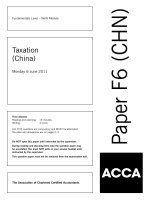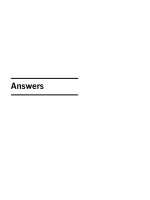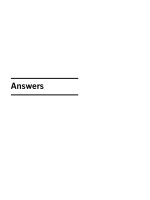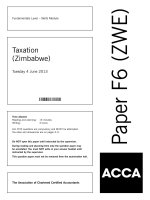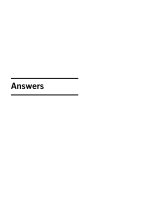ACCA f6 taxation south africa 2015 jun answer
Bạn đang xem bản rút gọn của tài liệu. Xem và tải ngay bản đầy đủ của tài liệu tại đây (214.22 KB, 8 trang )
Answers
Fundamentals Level – Skills Module, Paper F6 (ZAF)
Taxation (South Africa)
June 2015 Answers
and Marking Scheme
Section A
1
C
2
D
(15/40 x R15,000) + 24,000 = R29,625
Tutorial note: The foreign interest is fully taxable.
3
D
(R489,970 x 3·25% x 12) = R191,088 x (12,000/35,000) = R65,516 – (12,000 x R1·529) = R47,168
Tutorial note: The determined value includes value added tax as this is not recoverable by the company.
4
A
5
A
R57,000 x 14/114 = R7,000
6
C
Tutorial note: The failure of the other options makes this classification the only viable answer.
7
C
Tutorial note: While incorporation is sufficient to deem ABC Ltd a resident for South African income tax purposes,
the definition excludes as a resident a person deemed to be exclusively resident of another country for the
purposes of a tax treaty. As ABC Ltd only moved the place of effective management on 1 September 2014, it
only became non-resident from that date (in terms of the domestic law definition).
8
B
9
A
(R5,600,000 – R300,000) x 1·16 = R6,148,000
Tutorial note: The estimate should not be lower than the basic amount. As the last assessed period is more than
18 months prior to the assessment, that assessed taxable income (less any taxable capital gain) must be
increased by 8% per annum from the assessed year of assessment to the current year of assessment (i.e. in this
case 16%).
10 B
(((R675,000 x 100/114) x 0·3%) x 14/114) x 2 = R436
11 A
(R400,000 x 4/12) + (28,000 – 23,800) = R137,533
Tutorial note: As Jennifer spent more than 183 days in a 12-month period outside South Africa including
60 days of continuous absence, the remuneration earned whilst overseas is exempt. This does not extend to her
investment income. The result is that 8/12 of her annual remuneration is exempt and the monthly allowance is
fully exempt. The R23,800 exemption applicable to South African source interest is also deducted.
19
Marks
12 B
(R50,000 x 100%) + (R23,000 x 50%) + (R5,000 x 100%) = R66,500
Tutorial note: Where an item has a cost of less than R7,000, a full write-off may be claimed.
13 D
14 A
((R1,900,000 – R1,500,000) x 10%) + R20,000 = R60,000
Tutorial note: Despite the business use, the car remains a personal use asset and the capital gain or capital loss
would be fully excluded. 10% of the R400,000 capital gain will not qualify for the primary residence exclusion
(as the exclusion is only against private or domestic use). The yacht is too long to be a personal use asset and
so the gain is taxable.
15 D
2 marks each
20
–––
30
–––
Section B
1
Marks
Joseph Anybody
(a)
Residence
In order to determine Joseph’s residence status, both the subjective test of ‘ordinarily resident’ and the
objective test of ‘physical presence’ must be considered as a person will be considered to be resident in
South Africa if they meet either test.
½
Ordinarily resident
A person will be treated as ordinarily resident in South Africa if his or her permanent home, to which he or
she will normally return, is in South Africa. However, despite this, a continuous physical presence is not a
prerequisite to be ordinarily resident in South Africa.
1
In Joseph’s case, all factors appear to indicate that South Africa is not his permanent home – for example,
the emigration from South Africa in 2007, the clear statement of no intention to return to South Africa and
the major economic activity (his furniture business) being based in the United Kingdom.
1
Physical presence
The physical presence test must therefore be applied to determine Joseph’s residence. The test requires:
(i) Greater than 91 days presence in the current (2015) year of assessment;
(ii) Greater than 91 days presence in South Africa in each of the five preceding years of assessment;
(iii) Greater than 915 days presence in South Africa in aggregate over the five preceding years of
assessment.
½
If all factors are met, Joseph will be resident in South Africa for income tax purposes from the start of the
2015 year of assessment (i.e. 1 March 2014).
½
Tests (i) and (ii) are clearly met based on the facts presented, but as Joseph has only spent 508 days in
South Africa in the five preceding years of assessment (97 + 92 + 120 + 105 + 94), test (iii) is failed and
he will not be a South African resident for income tax purposes in the year of assessment 2015.
(b)
As the property is located in South Africa, it remains subject to capital gains tax regardless of the fact that
Joseph is not tax resident during the year of assessment 2015.
1
½
½
–––
2
–––
Aggregate capital gain
R
5,050,000
(4,000,000)
––––––––––
1,050,000
(30,000)
––––––––––
1,020,000
––––––––––
Proceeds (market value when intention changed)
Base cost
Capital gain
Less annual exclusion
Aggregate capital gain
2
1½
–––
6
–––
Capital gains tax event
A capital gains tax event may arise in the year of assessment 2015 as Joseph has changed his intention with
respect to the plot of land from capital (investment) to revenue (profit-making intention). This deemed
disposal arises on 15 September 2014 when Joseph decides to pursue the opportunity to develop the land
with respect to the secure complex.
(c)
½
½
1
½
½
–––
2
–––
10
–––
Judy Ltd
(a)
Value added tax (VAT)
Judy Ltd is not required to register for VAT as its taxable supplies are expected to be less than R1 million in
the next 12 months.
½
However, the company can choose to register as its turnover from taxable supplies in the next 12 months is
expected to be greater than R50,000.
½
None of Judy Ltd’s customers will be VAT registered. Therefore, if Judy Ltd registers for VAT, the disadvantage
is that the output VAT charged will represent an increased cost to the customer.
1
21
Marks
The advantage of registering for VAT is that Judy Ltd will be able to recover the input VAT suffered on its
purchases.
½
Therefore, the deciding factor on whether or not to register for VAT is whether or not the inputs reclaimable
are sufficient to warrant registration for VAT.
½
Annual VAT output: R350,400 x 14%
VAT inputs on machines (Year 1 only): R30,000 x 24 x 14%
Annual VAT inputs on running costs: R2,000 x 24 x 14%
VAT reclaimable in Year 1
R
49,056
(100,800)
(6,720)
––––––––
(58,464)
––––––––
In the short term, Judy Ltd will benefit from the input claims from the machines. However, in the long term,
if business is competitive, Judy Ltd may be unable to pass on the cost of the output VAT to its customers
through increased prices, which will impact on its profit margin.
(b)
½
–––
5
–––
Turnover tax
(R350,400 – R300,000) x 2% + R1,500 = R2,508
(c)
½
½
½
1
–––
Corporate income tax
Year 1
Income
Allowances on machines: R30,000 x 114/100 x 50% x 24
Interest on bank loan: (R30,000 x 114/100 x 24) x 8%
Running costs of machines: R2,000 x 114/100 x 24
Taxable income/(assessed loss)
R
350,400
(410,400)
(65,664)
(54,720)
––––––––
(180,384)
––––––––
½
1
1
½
–––
3
–––
Tax payable is nil.
Tutorial note: As Judy Ltd is not registered for VAT, the VAT charged on the machine and running expenses
are a non-recoverable and deductible cost to the company.
(d)
3
Judy Ltd should not register for turnover tax in the first year of operation as this will result in a charge to tax,
notwithstanding the fact that the company will realise an assessed loss.
1
–––
10
–––
Lesley Tulip
(a)
Lesley is over the age of 55 years throughout the 2015 year of assessment. The business she operates as a
sole proprietor is a small business (the market value of the business assets do not exceed R10 million) which
she has operated for at least 15 years.
Therefore, all of the disposals of business assets she makes in the 2015 year of assessment qualify for the
exclusion for small business assets. Under this exclusion, up to R1,800,000 of a taxpayer’s capital gains
can be excluded from tax.
(b)
2
–––
Aggregate capital gains – 2015 year of assessment
R
Business premises:
Proceeds
Base cost
Capital gain
Office furniture:
Proceeds (R32,000 less recoupment of R32,000)
Base cost (R80,000 less allowances R80,000)
Capital gain
22
5,500,000
(4,000,000)
––––––––––
1,500,000
––––––––––
½
½
0
0
––––––––––
0
––––––––––
½
½
Marks
R
Machine A:
Proceeds (R160,000 less recoupment of (R150,000 – R125,000))
Base cost (R150,000 less allowances of R25,000)
135,000
(125,000)
––––––––––
10,000
––––––––––
Capital gain
½
½
Private motor car – any capital gain or capital loss would be disregarded as this is a personal use asset.
½
Machine Z (2014 year of assessment):
Proceeds (R120,000 less recoupment of (R110,000 – R95,000))
Base cost (R110,000 less allowances of R15,000)
105,000
(95,000)
––––––––––
10,000
––––––––––
½
½
R10,000 x 5/6
8,333
––––––––––
1½
–––
Total gains before any reliefs
1,518,333
––––––––––
6
–––
Capital gain
This gain was rolled over against purchase of Machine A and deferred over six years.
In 2015 year of assessment there are five years left.
(c)
Small business asset exclusion:
R
1,800,000
(1,500,000)
(10,000)
––––––––––
290,000
––––––––––
Limit of amount to be excluded:
Business premises
Machine A
Limit remaining for future gains
In order to qualify for the exclusion, any future gains must be made within 24 months of the first disposal
which qualified (i.e. 24 months from 1 November 2014).
4
½
}
½
½
½
–––
2
–––
10
–––
Roofing Brothers (Pty) Ltd
(a)
Sales – R5,700,000 x 14/114
Progress payments – R450,000 x 14/114
Wages and salaries (the provision of employment service is not an enterprise)
Interest – exempt supply
Bank charges – R375 x 14/114
Export sale – R1,200,000 x 0%
Related costs – R950,000 x 14/114
Sale for scrap – R15,000 x 14/114
Double cab – input denied
Delivery truck – R950,000 x 14/114
Output (R)
700,000
55,263
Input (R)
0
0
46
0
116,667
1,842
––––––––
757,105
––––––––
0
116,667
––––––––
233,380
––––––––
Net VAT payable to SARS is R523,725 (R757,105 – R233,380).
(b)
Roofing Brothers (Pty) Ltd must file their VAT return for the two-month period May to June 2015 by
31 July 2015 (the last business day of the month following the end of the VAT period).
Payment of the R523,725 must be made by the same date.
Tutorial note: Payment means that the amount must have been cleared in the SARS bank account.
23
½
½
½
½
½
1
½
½
½
½
½
–––
6
–––
½
½
–––
1
–––
Marks
(c)
In order to be valid, a VAT invoice should contain the following:
The words ‘tax invoice’ in a prominent place
The name, address and VAT registration number of the supplier
The name, address and VAT registration number (where registered) of the recipient
The individualised serial number of the invoice
The date of issue of the invoice
A full and proper description of the goods or services supplied (indicating if second-hand goods, where
applicable)
The quantity or volume of the goods or services supplied
The value of the supply
The consideration (VAT inclusive) charged
The amount or rate of VAT included
Any SIX – ½ mark each – maximum
5
3
–––
10
–––
Charles Dlamini
Normal tax liability for the 2015 year of assessment
R
Net profit
Less interest on surplus funds (placed in individual partners hands
for determination of the interest exemption)
Less bad debt recovered (different profit ratio)
Add back depreciation
Wear and tear:
Older shop fittings: R2,400,000/6
Boardroom table and chairs R120,000/6 x 9/12
Minor furnishings (all individual items cost less than R7,000 so fully deductible)
New fittings: R1,800,000/6 x 11/12
Partners’ shares:
Charles 60% x R1,360,000
Taxable income for Charles
Partnership share
Salary
Bad debts recovered (based on the profit sharing allocation at the date
the debt was written off) – R12,000 x 50%
RAF contribution paid by partnership
Interest
Interest earned by partnership on surplus cash R25,000 x 60%
On partnership capital account R50,000 x 60%
Other interest
Less interest exemption
RAF contribution deduction (R100,000) limited to the greater of:
R1,750
R3,500 – R0
15% x R1,983,200
Tax per the tables: R195,212 + 40% (R1,883,200 – R673,100)
Less primary rebate (under 65)
Medical aid contribution rebate (514 + (172 x 2)) x 12
Less additional medical expenses rebate ((7,000 x 12) – (10,296 x 4)) +
45,000) = (87,816 – (7·5% x R1,883,200)) x 25% = <0 therefore no
additional rebate
Normal tax liability
24
15,000
30,000
40,000
–––––––
85,000
(23,800)
–––––––
R
1,467,000
½
(25,000)
(12,000)
650,000
––––––––––
2,080,000
1
1
½
(400,000)
(15,000)
(30,000)
(275,000)
––––––––––
1,360,000
––––––––––
½
1
½
1
816,000
½
816,000
1,000,000
½
6,000
100,000
1
½
½
½
½
61,200
––––––––––
1,983,200
½
(100,000)
––––––––––
1,883,200
––––––––––
679,252
(12,726)
(10,296)
1
0
––––––––––
656,230
½
½
1
1½
–––
–––
15
–––
Marks
6
Sun Energy Ltd
Taxable income for the 2015 year of assessment
(i) Sales
(ii) Recoupment of legal costs claimed (R30,000 + R55,000)
(iii) Patent 5% x R162,000
Legal costs (of a capital nature and therefore not deductible)
(iv) Salaries (qualify for R&D accelerated allowance) R250,000 x 150%
Machine used in the production of prototypes
R450,000 x 50%
Interest expense (does not qualify for the R&D allowance)
(v) Lease premium R50,000/120 months x 9 months
Leasehold improvements R450,000/119 months x 8 months
Lease payments R30,000 x 9 months
Manufacturing allowance for excess leasehold improvements
5% x (R480,000 – R450,000)
Sale of old building:
Manufacturing allowance for 2015 year of assessment
5% x R3,400,000
Recoupment of allowances:
(R5,000,000 limited to R3,400,000) less ((R3,400,000 –
(R3,400,000 x 12 x 5%))
Capital gains tax:
Proceeds less recoupment (R5,000,000 – R2,040,000)
Expenditure less allowances (R3,400,000 – R2,040,000)
Capital gain
No other gains or losses to aggregate therefore taxable capital
gain is 66·6% x R1,600,000
Assessed loss brought forward
The foreign loss may not be set off against South African revenue
R
10,500,000
(85,000)
(8,100)
0
(375,000)
(225,000)
(35,000)
(3,750)
(30,252)
(270,000)
½
1
1
½
1
½
1
1
1
1
½
(1,500)
½
(170,000)
½
2,040,000
2,960,000
(1,360,000)
––––––––––
1,600,000
––––––––––
1
1
1,065,600
(300,000)
0
–––––––––––
12,101,998
–––––––––––
Tutorial note: The machine used in the production of the prototypes does not qualify for the 150% relief for
research and development expenditure. Instead, the machine qualifies for the alternative accelerated allowance
of 50% for plant or machinery used for research and development.
25
1
½
½
1
–––
15
–––
